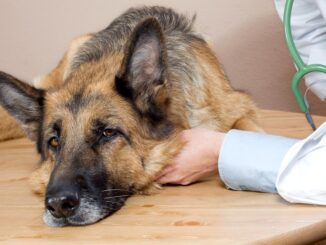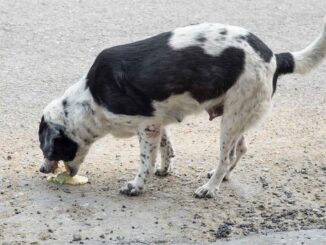
This article was updated on May 8th, 2023

The first instinct of any owner when they see blood in their dogs’ poop is to panic; blood is quite shocking to see, and owners will often jump to the conclusion that their dog has something seriously wrong.
While this can be the case, more commonly the cause of blood is mild and easily treatable. Some causes of blood in the stool may even resolve on their own, especially if your dog is still acting normal, and not showing other worrying symptoms.
Clearly, blood in diarrhea can indicate a serious underlying disease, especially if your dog seems unwell or showing other symptoms such as lethargy, vomiting or even collapse. In this case, you should take your dog to see the vet immediately.
However, if your dog is still acting normal and appears fine, and only has a little bit of blood in their stool, then there are some things that you may be able to try at home first.
What Does Blood in Diarrhea Look Like?
Bloody diarrhea is a broad term – the blood can take different forms and be of differing severities.
WARNING: A little farther down, we’re going to share some graphic pictures of examples of bloody diarrhea or poop. Your dog’s health is worth taking seriously, and we hope these pictures help.
The blood originates from damage to the fragile cells that line the intestines. These cells have a very good blood supply as they need to be able to carry nutrients away from the gut. Inflammation, infection, or trauma to these cells results in damage to the small blood vessels that supply them and thus release blood into the gut, staining the fecal matter that is produced. The amount of blood seen is proportional to the amount of damage done to these cells. View picture 1, and picture 2.
It’s also important to note that if you feed your dog a raw meat diet, then any blood in the meat will also have to pass through their system. So, if they eat a lot of raw beef and have very dark stools, this might be why!
Usually, the blood is mixed in with the fecal matter or just slightly tinges the overall stool. However, if your dog is producing lots of frank blood (not mixed with feces), then they may be actively bleeding and should see the vet immediately as an emergency matter.
Fresh or brightly colored blood often indicates that the source of the blood is in the lower intestines or colon, or even from your dog’s anus itself if they had been rubbing it, for example. There may often be mucus or ‘slime’ on the bloody feces as well.
Darker colored, or even bloody black dog stools usually indicate that the source of bleeding has come from higher up in the gastrointestinal tract such as the stomach or upper small intestines. The blood is then partially digested and broken down as it passed through your dog’s guts resulting in a darker appearance.
Is it Common for a Dog with Bloody Diarrhea to Act Normal?
This depends on the amount of bleeding. Mild damage to the intestinal wall may only result in a slight bleed that your dog doesn’t even notice, and that doesn’t affect them clinically in any other way. Usually, if they are acting normal, then the cause of the bleeding is mild, but this doesn’t mean it should be ignored.
What are the Most Likely Causes if Your Dog is Acting Normal?
While bloody diarrhea in a dog that is still acting normal may indicate a mild cause, it could also be the start of a more serious condition. Therefore, if you decide not to immediately take your dog to the vet, then you must monitor your dog’s stools very carefully to see if the situation worsens.
The most common causes of bloody diarrhea in a dog that is acting normal are:
1. Mild gut infection
Your dog may have picked up a mild viral or bacterial infection that has caused damage to the intestinal wall. So long as these pathogens don’t enter your dog’s bloodstream, the infection can be isolated in the gut, and the immune system can deal with it there.
2. Dietary intolerance/sensitivity
If your dog eats something that they are hypersensitive to, this can result in an inflammatory response in the gut. This inflammation can damage the intestinal cells and cause bleeding without affecting your dog in any other way.
3. Sore anus/anal glands
If your dog has an irritated or red anus, or has inflamed anal glands, then this can lead to blood appearing in the stools. Often your dog will be licking or trying to scratch their rear end but not always.
4. Worms/parasites
Parasites living in your dog’s gut will attack and feed on the fragile cells that line the intestines, resulting in the release of blood. The damage can be minimal in small numbers, and your dog often feels fine.
5. Stomach ulcer
Damage to the inner surface of the stomach wall results in the release of blood into the gut. This can often be caused by certain drugs such as non-steroidal anti-inflammatory drugs.
6. Rectal polyps.
These are small masses that can grow just inside your dog’s anus that can become irritated and inflamed.
However, there are other more serious causes of bloody diarrhea where your dog may initially act normal but deteriorate as the underlying condition worsens. These include parvovirus, hemorrhagic gastroenteritis, cancer, or even a gut blockage. If your dog is no longer acting normal, then take them to see your vet immediately.
Seven Steps to Take If Your Dog Has Bloody Diarrhea
Based on my clinical experience, I recommend the following steps:
Step 1: Feed them a bland food diet for the time being to eliminate any further irritation to their guts.
Step 2: Assess how your dog feels. Are there any other unusual symptoms that you’ve noticed? If they are unwell then take them to your vet.
Step 3: Have a look at their stool. What does the blood look like, how much blood is there, and how long has it been going on?
Step 4: Have a look at your dog’s anus. Is there any irritation or obvious source of the bleeding?
Step 5: Is your dog on any medication that might be causing gut irritation? Your vet can help with this, and they may want you to stop these drugs temporarily. Are they up to date with their worm preventatives?
Step 6: If your dog is still completely fine and acts normal, and the blood isn’t getting any worse, then leave it a few days to see if it resolves itself (call your vet to make sure this is ok).
Step 7: If your dog’s bloody diarrhea is still not resolving then take them to see your vet.
Related post: 11 bland diets to help dogs with an upset stomach.
Chat with a veterinarian online now about your dog’s blood in diarrhea – for just $1:
When in doubt, you can chat with a licensed veterinarian online now to discuss your dog’s situation, for just $1. Connect now with a veterinarian, or start a chat below:
Rates may differ for those residing outside the U.S. You’ll have access to a vet for 7 days.
Important Things to Consider When Your Dog Has Diarrhea
When you notice your dog has diarrhea, bloody or not, there are a few questions that you should be asking yourself such as:
- Has my dog eaten anything they shouldn’t have?
- Is my dog up to date with their deworming?
- Is my dog feeling well? Are they displaying any other signs of illness?
- If there is blood in the stool, what does it look like – darker vs fresh mucousy blood?
These are all questions that your vet will want to ask, so it’s good to be aware of the answers before your visit.
When Should You See Your Vet about Your Dog’s Bloody Diarrhea (If Your Dog is Otherwise Acting Normal)?
Of course, if your dog has bloody diarrhea AND appears unwell or is not acting normal, then you should take them to see your vet as soon as possible.
However, if your dog is acting normal, there are still reasons for them to be seen by the vet. If the bloody stools are persisting for more than a few days or if the amount of blood is increasing then you should take them to the vet as soon as you can. If you just want to be cautious, you should also call your vet who knows your dog’s history and will be in a better position to assess the situation.
FAQ About Bloody Dog Diarrhea with Dr. Alex Crow
Is My Dog’s Life at Risk with Bloody Diarrhea?
Lots of diseases can cause bloody diarrhea, and unfortunately, some of these can ultimately result in the death of your dog. Usually, bloody diarrhea isn’t too much to worry about so long as your dog is well otherwise. However, if they are unwell or an older dog then they should see the vet asap. If you are worried for any reason, even if your dog is still well then take them to the vet – it’s always better to be safe than sorry.
How Much Will This Likely Cost?
The cost of treating bloody diarrhea will depend very much on the underlying cause. Some cases of bloody diarrhea will self-resolve and therefore not cost anything. Some causes are mild and require a short course of treatment, costing anywhere between $50-200. However, more serious causes that require extensive investigation and even hospitalization can cost anywhere between $500-2000 or more.
Related posts about blood in dog stools:
Disclaimer: This website's content is not a substitute for veterinary care. Always consult with your veterinarian for healthcare decisions. Read More.









Be the first to comment